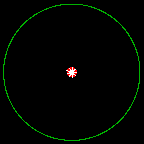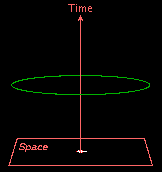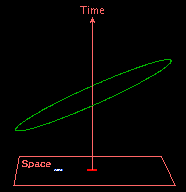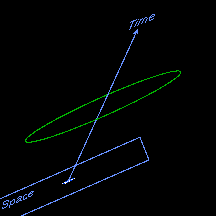Operational definition of simultaneity
 How can simultaneity,
the notion of events ocurring at the same time at different places,
be defined operationally?
One way is illustrated in the diagram.
Vermilion surrounds herself with a set of
mirrors,
equidistant from Vermilion.
She sends out a flash of light,
which reflects off the mirrors back to Vermilion.
How does Vermilion know that the mirrors are all the same distance from her?
Because the relected flash returns from the mirrors to Vermilion
all at the same instant.
Vermilion asserts that the light flash must have hit all the mirrors
simultaneously.
Vermilion also asserts that the instant when the light hit the mirrors
must have been the instant, as registered by her wristwatch,
precisely half way between the moment she emitted the flash and
the moment she received it back again.
If it takes, say, 2 seconds between flash and receipt,
then Vermilion concludes that the mirrors are 1 lightsecond away from her.
How can simultaneity,
the notion of events ocurring at the same time at different places,
be defined operationally?
One way is illustrated in the diagram.
Vermilion surrounds herself with a set of
mirrors,
equidistant from Vermilion.
She sends out a flash of light,
which reflects off the mirrors back to Vermilion.
How does Vermilion know that the mirrors are all the same distance from her?
Because the relected flash returns from the mirrors to Vermilion
all at the same instant.
Vermilion asserts that the light flash must have hit all the mirrors
simultaneously.
Vermilion also asserts that the instant when the light hit the mirrors
must have been the instant, as registered by her wristwatch,
precisely half way between the moment she emitted the flash and
the moment she received it back again.
If it takes, say, 2 seconds between flash and receipt,
then Vermilion concludes that the mirrors are 1 lightsecond away from her.
|
 How can simultaneity,
the notion of events ocurring at the same time at different places,
be defined operationally?
One way is illustrated in the diagram.
Vermilion surrounds herself with a set of
mirrors,
equidistant from Vermilion.
She sends out a flash of light,
which reflects off the mirrors back to Vermilion.
How does Vermilion know that the mirrors are all the same distance from her?
Because the relected flash returns from the mirrors to Vermilion
all at the same instant.
Vermilion asserts that the light flash must have hit all the mirrors
simultaneously.
Vermilion also asserts that the instant when the light hit the mirrors
must have been the instant, as registered by her wristwatch,
precisely half way between the moment she emitted the flash and
the moment she received it back again.
If it takes, say, 2 seconds between flash and receipt,
then Vermilion concludes that the mirrors are 1 lightsecond away from her.
How can simultaneity,
the notion of events ocurring at the same time at different places,
be defined operationally?
One way is illustrated in the diagram.
Vermilion surrounds herself with a set of
mirrors,
equidistant from Vermilion.
She sends out a flash of light,
which reflects off the mirrors back to Vermilion.
How does Vermilion know that the mirrors are all the same distance from her?
Because the relected flash returns from the mirrors to Vermilion
all at the same instant.
Vermilion asserts that the light flash must have hit all the mirrors
simultaneously.
Vermilion also asserts that the instant when the light hit the mirrors
must have been the instant, as registered by her wristwatch,
precisely half way between the moment she emitted the flash and
the moment she received it back again.
If it takes, say, 2 seconds between flash and receipt,
then Vermilion concludes that the mirrors are 1 lightsecond away from her.


